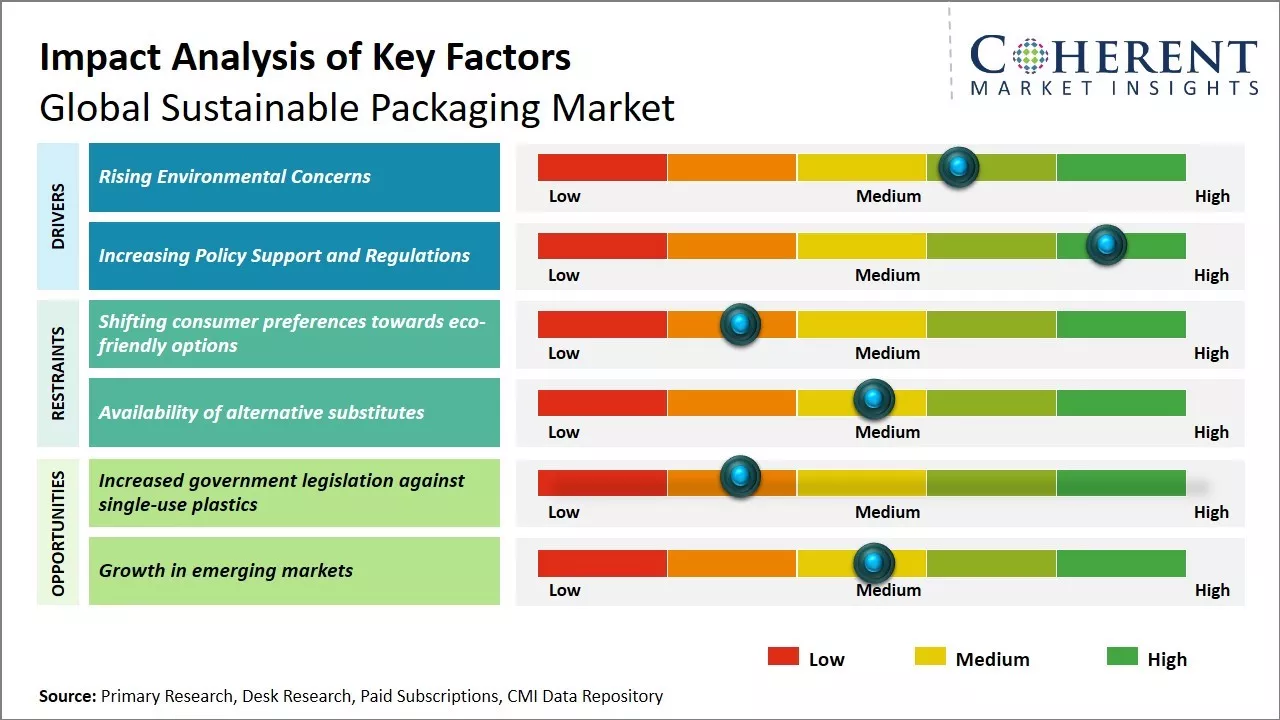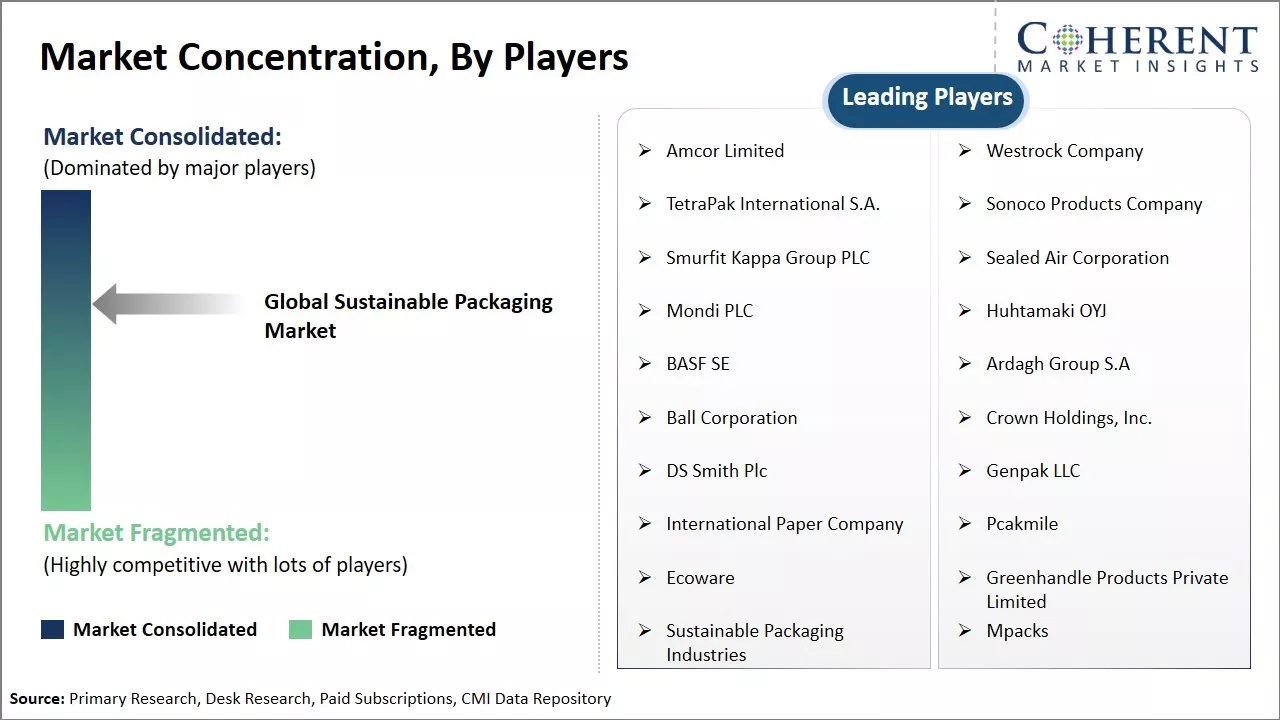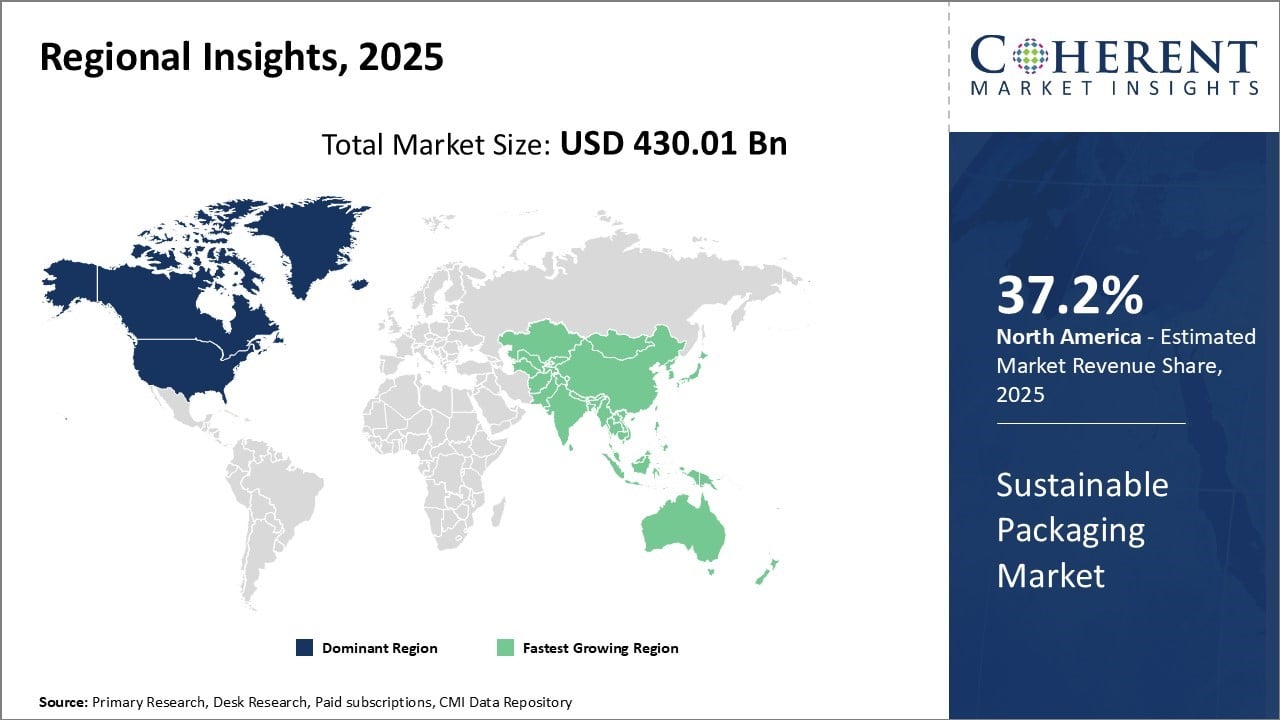Global Sustainable Packaging Market is estimated to be valued at USD 430.01 Bn in 2025 and is expected to reach USD 709.23 Bn by 2032, exhibiting a compound annual growth rate (CAGR) of 7.4% from 2025 to 2032.

To learn more about this report, Download Free Sample
The increasing focus on the environment and new laws encouraging sustainable practices have positive impacts on the growth of the sustainable packaging market. These packaging technology innovations are resulting in less waste and carbon emissions. A good instance of this is Amazon’s reduction in the use of plastic in their use of paper-based mailers. There is an increasing availability of compostable and recyclable packaging due to adeptness in materials science. There is an ability to achieve global targets when it comes to environmental sustainability and this trend is trending across countries.
|
Event |
Description and Impact |
|
EU Single-Use Plastics Directive and Extended Producer Responsibility Regulations |
|
|
China’s National Sword Policy and Plastic Import Restrictions |
|
|
Advanced Packaging Technology Breakthroughs and Scaling |
|
Uncover macros and micros vetted on 75+ parameters: Get instant access to report
The global sustainable packaging market is expected to grow at an exponential rate during the projected timeframe. Along with the ecological benefits, the economic benefits offered by sustainable packaging are projected to fuel the demand for sustainable packaging from various end-users.
Moreover, expanding end-users in the market is another factor observed as a driver for the growth of the sustainable packaging market. Along with the food and cosmetics, healthcare, pharmaceuticals, electronics, and chemical industries are expected to boost the utilization of sustainable packaging in upcoming years, this will create a plethora of opportunities for market players.

To learn more about this report, Download Free Sample
Sustainable packaging has emerged as an important issue globally in the past decade. With increasing environmental degradation and the looming threats of climate change, people around the world are becoming more concerned about the negative impact of plastic and other non-degradable materials that are commonly used in packaging.
There is a growing realization that if one does not switch to more eco-friendly alternatives, one may severely damage the planet in irreversible ways. Many national governments and international organizations are highlighting the need to adopt circular economy principles and promote sustainable practices to achieve long term environmental sustainability. Regional bans and regulations on single-use plastics have also raised awareness about sustainable packaging.
More companies and brands are facing pressure from environmentally-conscious consumers to reduce waste and use packaging made from recycled or renewable sources. Young consumers, in particular, want to buy from companies that are committed to green values. Various studies have shown that many would be willing to pay slightly higher prices for products in sustainable packaging.
Non-governmental organizations are actively campaigning on issues like plastic pollution in oceans. The media also regularly reports on topics such as the alarming increase in plastic waste and its harmful effects. These factors have made sustainability a priority for government policymakers, businesses and individuals.
Increasing Policy Support and Regulations is significantly driving the growth of Global Sustainable Packaging Market. Governments across the world are introducing stringent regulations and policies to curb plastic waste generation and promote use of sustainable and eco-friendly packaging options.
For instance, European Union passed a directive in 2019 banning select single-use plastic items like straws, cutlery, and plates by 2021. The directive aims to reduce marine plastic litter and move EU countries towards more circular economy. Similarly, governments in many Asian and Latin American countries have either banned or imposed heavy tax on single-use plastic bags and Styrofoam containers. These increasing regulatory pressures are encouraging packaging manufacturers and brands to shift towards more sustainable packaging materials and solutions.
Many major brands and retailers have announced commitments and targets to use recycled content in their packaging or make them reusable/recyclable by certain timelines. For example, major retailers like Walmart, Target, and Aldi have targets that 100% of their private label packaging will be recyclable, reusable or compostable by 2025.
Food and beverage giants like PepsiCo, Coca-Cola, and Nestle have also committed to use minimum 25% recycled plastic in their bottles by 2025. According to United Nations Environment Programme (UNEP) report published in 2022, plastic pollution has severe economic impacts with losses estimated at $3-12 billion to marine ecosystems annually. The report also highlighted need for global agreement on fixing plastic pollution.
Increased government legislation against single-use plastics will drive packaging innovation. More companies are committing to sustainability goals which will raise demand. Consumers, especially millennials and Gen Z, indicate a strong willingness to pay extra for eco-friendly products.
In terms of material type, paper segment is estimated to contribute the 36.1% of the market share in 2025, owing to its renewable nature and wide array of uses. Paper is derived from wood or plant fibers, and can be regrown and replenished, making it a sustainable material choice. It also has the advantage of being lightweight yet durable, especially when layered or coated.
Paper is highly versatile in the forms it can take such as cardboard, cartons, bags, boxes, and wrappings. It is suitable for most packaging applications across various industries. Being renewable and biodegradable provides paper an edge over plastic and metal materials. The widest use of paper is in the corrugated packaging segment. It offers strength as well as printability, and is used extensively for transit packaging of goods.
Paper also performs well as a wrapping or carrier for food and other consumable products. New innovations are expanding paper's uses further via techniques like wax or plastic coatings that improve its barrier properties. Overall, paper's natural, environment-friendly composition and adaptability make it the top choice in sustainable packaging materials.
In terms of process, recycled packaging segment is estimated to contribute the 38.3% of the market share in 2025, due to growing push for circular economy initiatives. Recycled packaging involves using post-consumer or post-industrial scrap materials to manufacture new packaging. This closed loop process provides both economic and ecological benefits.
Recycling saves valuable raw material resources from being used to make new packaging from scratch. It takes much less energy to reprocess waste materials than to extract and manufacture virgin fibers, plastics, metals and others. Recycling also reduces industrial pollution as well as greenhouse gas emissions associated with material extraction and transport. Many governments now mandate minimum recycled content levels in packaging or offer incentives for its use.
Brand owners also promote the recyclability of their packages to appeal to environmentally conscious consumers. The availability of infrastructure to collect, sort and reprocess waste packaging back into feedstock has increased drastically. Advanced recycling technologies are making even multi-material flexible pouches and films recyclable now.
With the linear take-make-waste model being replaced worldwide, recycled packaging provides a hands-on way for industries and individuals to participate in the circular flow of resources. It embraces the classic reduce-reuse-recycle mantra and brings packaging production more in line with ecological sustainability principles. This boosts its widespread preference and higher share over other processes.
In terms of end user industry, food and beverage segment is estimated to contribute the 38.3% of the market share in 2025 due to specific regulatory requirements and consumer demands in this sector. Stringent safety and hygiene rules determine how food is packaged. Yet consumers increasingly seek sustainable options and companies face government waste reduction targets. Recycled packaging satisfies both through techniques like sterile processing of waste paper fibers and use of high-quality resins in plastic recycling.
Food-grade recycled paper and rigid plastic help replace virgin material’s intensive layers and trays. Recycled material is also ideal for secondary or tertiary food packaging like shipping boxes and bags. Branded items wish to display green credentials through such outer coverings. Shelf-stable and dry grocery goods suit recycled paperboard cartons and wrappings, while recycled PET and HDPE work for bottles and jugs.

To learn more about this report, Download Free Sample
North America is expected to maintain its position as the largest market for sustainable packaging in 2025, accounting for an estimated 37.2% share of the global market. This leadership is driven by strong regulatory frameworks, growing environmental awareness, and active participation from major packaging companies and consumer brands.
The U.S. and Canada have implemented a range of federal and state-level policies aimed at reducing plastic waste and encouraging the use of recyclable, compostable, and reusable packaging materials. Government-backed initiatives and bans on single-use plastics have accelerated the shift toward more sustainable alternatives across multiple industries, including food & beverage, personal care, and e-commerce.
Additionally, leading consumer goods companies in North America are pledging to transition to eco-friendly packaging solutions in response to mounting consumer demand. The region’s mature recycling infrastructure, high per-capita consumption, and widespread public support for environmental sustainability make it a highly attractive market for innovation in sustainable packaging.
Asia Pacific is emerging as the fastest-growing region in the global sustainable packaging market and is projected to dominate the landscape in the coming years. Rapid industrialization, urbanization, and rising environmental concerns across countries such as China, India, Indonesia, and Vietnam are fueling strong demand for sustainable packaging solutions.
The region’s robust GDP growth, expanding middle-class population, and rising standards of living are increasing consumption of packaged consumer goods—driving both domestic demand and regulatory focus on sustainability. Governments in several Asia Pacific countries are implementing policies to reduce plastic pollution and encourage sustainable materials, including incentives for manufacturers to adopt eco-friendly packaging formats.
Asia Pacific’s expanding manufacturing base, combined with growing awareness around environmental responsibility, positions the region as a key driver of global market growth in sustainable packaging.
China is a leading force in the Asia Pacific sustainable packaging market, backed by strong government mandates and national-level plastic reduction policies. The country’s vast consumer market and rapidly growing e-commerce sector are driving demand for innovative, biodegradable, and recyclable packaging formats. Strategic investments in green technology and circular economy initiatives are helping China scale sustainable solutions while reducing its reliance on traditional plastics.
India’s sustainable packaging market is witnessing rapid growth due to increased environmental regulation, urban expansion, and rising consumer awareness. The government has imposed strict bans on single-use plastics and is actively promoting biodegradable and recyclable packaging through national programs like Swachh Bharat and the Plastic Waste Management Rules. India’s expanding FMCG sector and push for sustainable development are fostering an ecosystem for local innovation in eco-friendly packaging materials.
Indonesia is emerging as a high-potential market for sustainable packaging, driven by growing public concern over marine plastic pollution and strong governmental commitments to environmental preservation. Efforts to reduce plastic usage in retail and food sectors are complemented by public-private partnerships focused on developing affordable, sustainable packaging alternatives. The country’s large population and rising consumer spending create a favorable environment for market expansion.
Vietnam’s sustainable packaging market is growing rapidly, supported by increasing government regulation and global export requirements. As a key manufacturing hub, Vietnam is under pressure from international partners to adopt environmentally responsible practices. Local companies are investing in recyclable and compostable packaging to stay competitive. The country’s economic growth, export-oriented industries, and shifting consumer preferences are accelerating the adoption of sustainable packaging solutions.
| Report Coverage | Details | ||
|---|---|---|---|
| Base Year: | 2024 | Market Size in 2025: | USD 430.01 Bn |
| Historical Data for: | 2020 To 2024 | Forecast Period: | 2025 To 2032 |
| Forecast Period 2025 to 2032 CAGR: | 7.4% | 2032 Value Projection: | USD 709.23 Bn |
| Geographies covered: |
|
||
| Segments covered: |
|
||
| Companies covered: |
Amcor Limited, Westrock Company, TetraPak International S.A., Sonoco Products Company, Smurfit Kappa Group PLC, Sealed Air Corporation, Mondi PLC, Huhtamaki OYJ, BASF SE, Ardagh Group S.A, Ball Corporation, Crown Holdings, Inc., DS Smith Plc, Genpak LLC, International Paper Company, Pcakmile, Ecoware , Greenhandle Products Private Limited, Sustainable Packaging Industries, Mpacks |
||
| Growth Drivers: |
|
||
| Restraints & Challenges: |
|
||
Uncover macros and micros vetted on 75+ parameters: Get instant access to report
Share
Share
About Author
Shivam Bhutani has 6 years of experience in market research and strategy consulting. He is a Market Research Consultant with strong analytical background. He is currently an MBA candidate specializing in Business Analytics from BITS Pilani.
He is adept at navigating diverse roles from sales and marketing to research and strategy consulting. He excels in market estimation, competitive intelligence, pricing strategy, and primary research. He is skilled at analysing large datasets to provide precise insights, helping clients in achieving strategic transformation across various industries. He is skilled in leveraging data visualization techniques to drive innovation and enhance business processes.
Missing comfort of reading report in your local language? Find your preferred language :
Transform your Strategy with Exclusive Trending Reports :
Frequently Asked Questions
Joining thousands of companies around the world committed to making the Excellent Business Solutions.
View All Our Clients